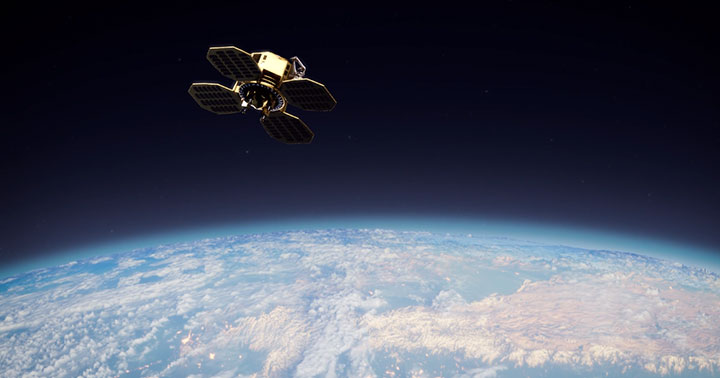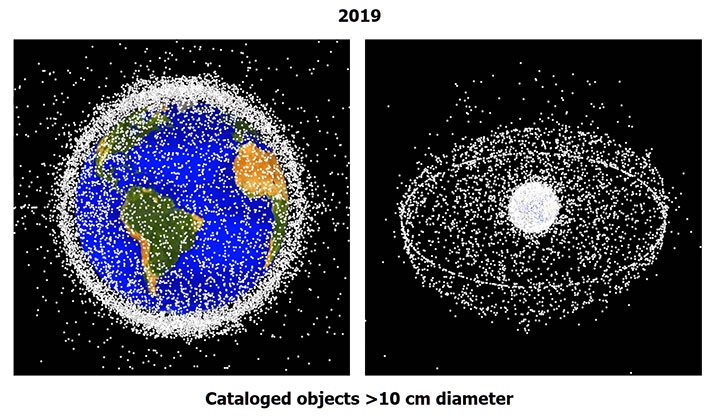 This image shows a Scout Space satellite, outfitted with sensors and AI capabilities for on-orbit space situational awareness. The company was founded in 2019 with the goal to “see anything in space, from space.” (Source: Scout Space)
This image shows a Scout Space satellite, outfitted with sensors and AI capabilities for on-orbit space situational awareness. The company was founded in 2019 with the goal to “see anything in space, from space.” (Source: Scout Space)
WASHINGTON – Commercial space situational awareness (SSA) capabilities, once rooted firmly on terra firma, are expanding into space, a vantage point that proponents say will increase the currency and accuracy of information in an increasingly congested orbital environment.
Thousands of satellites have been launched over the last decade, mostly to low Earth orbit, and many thousands more are planned in the coming years, raising concerns about collisions that could litter the environment with destructive debris. This is driving demand for SSA data beyond what is available from the U.S. Department of Defense’s space surveillance network, which has long been the default source of this information.
Commercial SSA capabilities have grown dramatically over the last decade, and include data processing and visualization software, increasingly leveraging artificial intelligence (AI), as well as global networks of tracking sensors. Once confined to the ground, these commercial sensors are now moving into space.
Among the pioneers of this migration is Scout Space of Alexandria, Va., which has developed a satellite payload that includes optical sensors and AI-enabled software for space-object visualization and characterization.
In the near term, this capability supports individual spacecraft rendezvous and proximity operations, said Eric Ingram, Scout Space’s co-founder and chief executive. Longer term, Ingram envisions a constellation of hosted Scout Space payloads contributing to a more comprehensive and precise understanding of the orbital environment.
Filling the Gaps
Over the last decade, companies like Comspoc, Kratos, LeoLabs and ExoAnalytic Solutions have been building out global networks of ground-based sensors, including optical telescopes, radars and RF sensors to monitor space objects as they pass overhead. Along with international capabilities, these networks complement the Space Force’s monitoring systems, located on the ground and in space.
Space-based observations can fill in many of the details missed by ground-based sensors, said Ingram. “From our perspective, more space-based observations are necessary to de-risk the space environment,” he said.
Scout Space’s initial Scout-Vision product combines proprietary software with off-the-shelf optical sensors on individual spacecraft to visualize, identify and geolocate nearby objects. A key advantage of space-based sensors is their ability to maintain constant custody of an object as it maneuvers in space, Ingram said.
“Lots of spacecraft can do complex maneuvers, and as that trend continues, ground-based sensors will lose objects,” Ingram said. “The paradigm change is continuous custody – we’re working on continuous custody of objects we know about and increasing [awareness] of objects we don’t know about.”
Stereoscopic space-based observations also can accurately determine the altitude of orbital objects, something that is difficult for ground-based sensors unless the object’s size and shape are known, Ingram said. “We can take a ton of uncertainty out of the measurements,” he said.
Scout Space is not alone in its ambitions for space-based space surveillance. Montreal, Canada-based NorthStar Earth and Space, for example, has raised $105 million to date for a planned satellite constellation for both ground and space surveillance. NorthStar plans to launch an initial batch of four satellites – which the company says will be able to monitor all near-Earth orbits – on an upcoming flight of Rocket Lab’s Electron rocket.
The first in-orbit test of Scout-Vision took place aboard Orbit Fab’s Tanker-001 Tenzing in-space fuel depot demonstration, which launched in June 2021. That mission proved the concept while providing flight heritage for the first-generation system, Ingram said.
Two more Scout-Vision payloads will be launched in the first quarter of 2024, including one hosted aboard space transportation and infrastructure provider Momentus Space’s Vigoride space tug. The vision system will support maneuvers of Vigoride, which is designed to deploy rideshare payloads to different orbits, Ingram said.
Future demonstrations are in the works to demonstrate more advanced Scout-Vision capabilities, including longer-range observations, Ingram said.
Advancing Big-Picture SSA
While Scout Space’s products are initially focused on supporting individual spacecraft maneuvers, the company fully expects to contribute to SSA more broadly. For example, the company recently was selected by the Intelligence Advanced Research Projects Agency to participate in the Space Debris Identification and Tracking program, which is aimed at advancing the United States’ ability to track space debris objects smaller than 10 centimeters across, now largely invisible to existing sensors.
 This NASA model shows the amount of tracked orbital debris in LEO and GEO larger than 10 centimeters. (Source: NASA Orbital Debris Program Office)
This NASA model shows the amount of tracked orbital debris in LEO and GEO larger than 10 centimeters. (Source: NASA Orbital Debris Program Office)
Ingram envisions a constellation of Scout-Vision-hosted payloads strategically positioned to provide big-picture SSA. Scout Space is in discussions with multiple constellation operators in that regard, he said.
Such a capability would be relevant to the Traffic Coordination System for Space (TraCCS), the civilian SSA service being created by the U.S. National Oceanic and Atmospheric Administration’s Office of Space Commerce. Former NASA astronaut Sandra Magnus, a contractor serving as TraCCS acting program manager and chief engineer, said in a July webinar that one of the guiding tenets of the effort is to leverage commercial SSA capabilities “to the greatest extent possible.”
The TraCCS development effort, still in its early stages, is expected to get off the ground in earnest next year. “Scout Space is ready and willing to be a beneficial contributor to what the government is working on,” Ingram said.
More broadly, Ingram wants to send the message that given the exponentially growing importance and utilization of space, proactive measures are required to preserve that environment for future generations.
“The more assets we’re able to give vision capabilities, the more illumination we‘ll have on the space ecosystem,” Ingram said. “And the more encouragement there is from regulations on the importance of these capabilities, the more we can get these sorts of things incorporated into spacecraft operating procedures.”
Explore More:
Podcast: Tracking LEOs, Growth in Resident Space Objects and the Problem with Uncertainty
Advances in Automation Show Potential to Improve Space Situational Awareness
Satellite Disposal Scorecard: Commercial Better than Military
DoD’s Commercial Space Domain Awareness Dilemma
